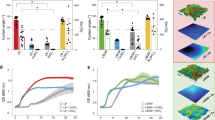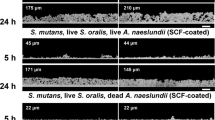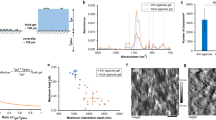Abstract
Bacteria use a process called quorum sensing to communicate and orchestrate collective behaviours, including virulence factor secretion and biofilm formation. Quorum sensing relies on the production, release, accumulation and population-wide detection of signal molecules called autoinducers. Here, we develop concepts to coat surfaces with quorum-sensing-manipulation molecules as a method to control collective behaviours. We probe this strategy using Staphylococcus aureus. Pro- and anti-quorum-sensing molecules can be covalently attached to surfaces using click chemistry, where they retain their abilities to influence bacterial behaviours. We investigate key features of the compounds, linkers and surfaces necessary to appropriately position molecules to interact with cognate receptors and the ability of modified surfaces to resist long-term storage, repeated infections, host plasma components and flow-generated stresses. Our studies highlight how this surface approach can be used to make colonization-resistant materials against S. aureus and other pathogens and how the approach can be adapted to promote beneficial behaviours of bacteria on surfaces.
This is a preview of subscription content, access via your institution
Access options
Access Nature and 54 other Nature Portfolio journals
Get Nature+, our best-value online-access subscription
$29.99 / 30 days
cancel any time
Subscribe to this journal
Receive 12 digital issues and online access to articles
$119.00 per year
only $9.92 per issue
Buy this article
- Purchase on Springer Link
- Instant access to full article PDF
Prices may be subject to local taxes which are calculated during checkout





Similar content being viewed by others
References
Wang, B. & Muir, T. W. Regulation of virulence in Staphylococcus aureus: molecular mechanisms and remaining puzzles. Cell Chem. Biol. 23, 214–224 (2016).
Kong, K. F., Vuong, C. & Otto, M. Staphylococcus quorum sensing in biofilm formation and infection. Int. J. Med. Microbiol. 296, 133–139 (2006).
Drescher, K. et al. Architectural transitions in Vibrio cholerae biofilms at single-cell resolution. Proc. Natl Acad. Sci. USA 113, E2066–E2072 (2016).
Yan, J., Sharo, A. G., Stone, H. A., Wingreen, N. S. & Bassler, B. L. Vibrio cholerae biofilm growth program and architecture revealed by single-cell live imaging. Proc. Natl Acad. Sci. USA 113, E5337–E5343 (2016).
Nadell, C. D., Drescher, K. & Foster, K. R. Spatial structure, cooperation and competition in biofilms. Nat. Rev. Microbiol. 14, 589–600 (2016).
Waters, C. M. & Bassler, B. L. Quorum sensing: cell-to-cell communication in bacteria. Annu. Rev. Cell Dev. Biol. 21, 319–346 (2005).
Papenfort, K. & Bassler, B. L. Quorum sensing signal-response systems in Gram-negative bacteria. Nat. Rev. Microbiol. 14, 576–588 (2016).
Novick, R. P. & Geisinger, E. Quorum sensing in staphylococci. Annu. Rev. Genet. 42, 541–564 (2008).
Dinges, M. M., Orwin, P. M. & Schlievert, P. M. Exotoxins of Staphylococcus aureus. Clin. Microbiol. Rev. 13, 16–34 (2000).
Arvidson, S. & Tegmark, K. Regulation of virulence determinants in Staphylococcus aureus. Int. J. Med. Microbiol. 291, 159–170 (2001).
Hammer, B. K. & Bassler, B. L. Quorum sensing controls biofilm formation in Vibrio cholerae. Mol. Microbiol. 50, 101–104 (2003).
Hsiao, A. et al. Members of the human gut microbiota involved in recovery from Vibrio cholerae infection. Nature 515, 423–426 (2014).
Ismail, A. S., Valastyan, J. S. & Bassler, B. L. A host-produced autoinducer-2 mimic activates bacterial quorum sensing. Cell Host Microbe 19, 470–480 (2016).
O'Loughlin, C. T. et al. A quorum-sensing inhibitor blocks Pseudomonas aeruginosa virulence and biofilm formation. Proc. Natl Acad. Sci. USA 110, 17981–17986 (2013).
Sully, E. K. et al. Selective chemical inhibition of agr quorum sensing in Staphylococcus aureus promotes host defense with minimal impact on resistance. PLoS Pathog. 10, e1004174 (2014).
Otto, M. Quorum-sensing control in Staphylococci—a target for antimicrobial drug therapy? FEMS Microbiol. Lett. 241, 135–141 (2004).
Cegelski, L., Marshall, G. R., Eldridge, G. R. & Hultgren, S. J. The biology and future prospects of antivirulence therapies. Nat. Rev. Microbiol. 6, 17–27 (2008).
Kim, M. K., Ingremeau, F. B., Zhao, A., Bassler, B. L. & Stone, H. A. Local and global consequence of flow on bacterial quorum sensing. Nat. Microbiol. 1, 15005 (2016).
Lu, H. D. et al. Modulating Vibrio cholerae quorum-sensing-controlled communication using autoinducer-loaded nanoparticles. Nano Lett. 15, 2235–2241 (2015).
Persat, A. et al. The mechanical world of bacteria. Cell 161, 988–997 (2015).
Kim, M. K., Drescher, K., Pak, O. S., Bassler, B. L. & Stone, H. A. Filaments in curved streamlines: rapid formation of Staphylococcus aureus biofilm streamers. New J. Phys. 16, 065024 (2014).
Broderick, A. H. et al. Surface coatings that promote rapid release of peptide-based AgrC inhibitors for attenuation of quorum sensing in Staphylococcus aureus. Adv. Healthc. Mater. 3, 97–105 (2014).
Ho, K. K. K. et al. Quorum sensing inhibitory activities of surface immobilized antibacterial dihydropyrrolones via click chemistry. Biomaterials 35, 2336–2345 (2014).
Lowy, F. D. Staphylococcus aureus infections. New Engl. J. Med. 339, 2026–2027 (1998).
Gordon, R. J. & Lowy, F. D. Pathogenesis of methicillin-resistant Staphylococcus aureus infection. Clin. Infect. Dis. 46, S350–S359 (2008).
Zhang, L. S., Gray, L., Novick, R. P. & Ji, G. Y. Transmembrane topology of AgrB, the protein involved in the post-translational modification of AgrD in Staphylococcus aureus. J. Biol. Chem. 277, 34736–34742 (2002).
Wang, B. Y., Zhao, A. S., Novick, R. P. & Muir, T. W. Key driving forces in the biosynthesis of autoinducing peptides required for staphylococcal virulence. Proc. Natl Acad. Sci. USA 112, 10679–10684 (2015).
Lina, G. et al. Transmembrane topology and histidine protein kinase activity of AgrC, the agr signal receptor in Staphylococcus aureus. Mol. Microbiol. 28, 655–662 (1998).
Wang, B. Y., Zhao, A. S., Novick, R. P. & Muir, T. W. Activation and inhibition of the receptor histidine kinase AgrC occurs through opposite helical transduction motions. Mol. Cell 53, 929–940 (2014).
Koenig, R. L., Ray, J. L., Maleki, S. J., Smeltzer, M. S. & Hurlburt, B. K. Staphylococcus aureus AgrA binding to the RNAIII-agr regulatory region. J. Bacteriol. 186, 7549–7555 (2004).
Fechter, P., Caldelari, I., Lioliou, E. & Romby, P. Novel aspects of RNA regulation in Staphylococcus aureus. FEBS Lett. 588, 2523–2529 (2014).
Lyon, G. J., Wright, J. S., Muir, T. W. & Novick, R. P. Key determinants of receptor activation in the agr autoinducing peptides of Staphylococcus aureus. Biochemistry 41, 10095–10104 (2002).
Hong, V., Presolski, S. I., Ma, C. & Finn, M. G. Analysis and optimization of copper-catalyzed azide-alkyne cycloaddition for bioconjugation. Angew. Chem. Int. Ed. 48, 9879–9883 (2009).
Emilsson, G. et al. Strongly stretched protein resistant poly(ethylene glycol) brushes prepared by grafting-to. ACS Appl. Mater. Inter. 7, 7505–7515 (2015).
Cisar, E. A., Geisinger, E., Muir, T. W. & Novick, R. P. Symmetric signalling within asymmetric dimers of the Staphylococcus aureus receptor histidine kinase AgrC. Mol. Microbiol. 74, 44–57 (2009).
Vollmer, W., Blanot, D. & de Pedro, M. A. Peptidoglycan structure and architecture. FEMS Microbiol. Rev. 32, 149–167 (2008).
Traber, K. E. et al. Agr function in clinical Staphylococcus aureus isolates. Microbiology 154, 2265–2274 (2008).
Khodaparast, S., Kim, M. K., Silpe, J. & Stone, H. A. Bubble-driven detachment of bacteria from confined microgeometries. Environ. Sci. Technol. 51, 1340–1347 (2017).
Vasilev, K., Cook, J. & Griesser, H. J. Antibacterial surfaces for biomedical devices. Expert Rev. Med. Devices 6, 553–567 (2009).
Gallo, J., Holinka, M. & Moucha, C. S. Antibacterial surface treatment for orthopaedic implants. Int. J. Mol. Sci. 15, 13849–13880 (2014).
Lee, J. J. et al. Synthetic ligand-coated magnetic nanoparticles for microfluidic bacterial separation from blood. Nano Lett. 14, 1–5 (2014).
Boles, B. R. & Horswill, A. R. agr-mediated dispersal of Staphylococcus aureus biofilms. PLoS Pathog. 4, e1000052 (2008).
Davies, D. Understanding biofilm resistance to antibacterial agents. Nat. Rev. Drug Discov. 2, 114–122 (2003).
Painter, K. L., Krishna, A., Wigneshweraraj, S. & Edwards, A. M. What role does the quorum-sensing accessory gene regulator system play during Staphylococcus aureus bacteremia? Trends Microbiol. 22, 676–685 (2014).
Huycke, M. M., Spiegel, C. A. & Gilmore, M. S. Bacteremia caused by hemolytic, high-level gentamicin-resistant Enterococcus faecalis. Antimicrob. Agents Chemother. 35, 1626–1634 (1991).
Cook, L. C. & Federle, M. J. Peptide pheromone signaling in Streptococcus and Enterococcus. FEMS Microbiol. Rev. 38, 473–492 (2014).
Nakayama, J. et al. Development of a peptide antagonist against fsr quorum sensing of Enterococcus faecalis. ACS Chem. Biol. 8, 804–811 (2013).
Gray, B., Hall, P. & Gresham, H. Targeting agr- and agr-like quorum sensing systems for development of common therapeutics to treat multiple Gram-positive bacterial infections. Sensors 13, 5130–5166 (2013).
Fujii, T. et al. Two homologous agr-like quorum-sensing systems cooperatively control adherence, cell morphology, and cell viability properties in Lactobacillus plantarum WCFS1. J. Bacteriol. 190, 7655–7665 (2008).
Wang, I. N., Smith, D. L. & Young, R. Holins: the protein clocks of bacteriophage infections. Annu. Rev. Microbiol. 54, 799–825 (2000).
Goedhart, J. et al. Structure-guided evolution of cyan fluorescent proteins towards a quantum yield of 93%. Nat. Commun. 3, 751 (2012).
Nadell, C. D., Drescher, K., Wingreen, N. S. & Bassler, B. L. Extracellular matrix structure governs invasion resistance in bacterial biofilms. ISME J. 9, 1700–1709 (2015).
Chen, J., Yoong, P., Ram, G., Torres, V. J. & Novick, R. P. Single-copy vectors for integration at the SaPI1 attachment site for Staphylococcus aureus. Plasmid 76, 1–7 (2014).
Lyon, G. J., Mayville, P., Muir, T. W. & Novick, R. P. Rational design of a global inhibitor of the virulence response in Staphylococcus aureus, based in part on localization of the site of inhibition to the receptor-histidine kinase, AgrC. Proc. Natl Acad. Sci. USA 97, 13330–13335 (2000).
Charpentier, E. et al. Novel cassette-based shuttle vector system for Gram-positive bacteria. Appl. Environ. Microbiol. 70, 6076–6085 (2004).
Acknowledgements
The authors acknowledge the Novick laboratory for providing S. aureus strains and plasmids. The authors thank N. Wingreen for discussions about heterogeniety, J. Yan for image analysis, B. Wang for discussion and mentoring in S. aureus genetic techniques, B. Bratton for discussions about single-molecule microscopy, I. Pelczer and K. Conover for the NMR measurements and D. Dabbs for help with the FTIR measurement. The authors acknowledge members of the B.L.B., H.A.S. and T.W.M. laboratories for suggestions. This work was supported by NSF grant MCB-1344191 (to B.L.B. and H.A.S.), the Howard Hughes Medical Institute, NIH grant 2R37GM065859 and NSF grant MCB-0948112 (to B.L.B.), NIH grant R01 AI042783 (to T.W.M.) and a STX fellowship (to M.K.K.).
Author information
Authors and Affiliations
Contributions
M.K.K., H.A.S. and B.L.B. conceived the idea. M.K.K., A.Z., T.W.M., H.A.S. and B.L.B. designed the experiments. M.K.K. and A.Z. performed the majority of the experiments. A.W. helped with the solution assay. M.K.K., A.Z., A.W. and Z.Z.B. contributed new reagents/analytic tools. M.K.K., A.Z., T.W.M., H.A.S. and B.L.B. analysed the data. M.K.K., A.Z., H.A.S. and B.L.B. wrote the manuscript.
Corresponding authors
Ethics declarations
Competing interests
The authors declare no competing financial interests.
Supplementary information
Supplementary information
Supplementary Figures 1–8; Supplementary Tables 1 and 2; Supplementary Note 1; Supplementary Methods; Supplementary References; colour-blind-friendly versions of Figures 1–5 and Supplementary Figures 1–8. (PDF 6644 kb)
Supplementary Video 1
S. aureus Agr quorum sensing is activated by surface attached AIP-I. Time series of merged fluorescence images of the S. Aureus reporter strain in the presence of Surface-PEG10000-triazole-AIP-I (top left), Surface-PEG10000-triazole-AIP-I + 2.5 μM TrAIP-II in solution (top right), Surface-PEG10000-azide (bottom left), and Surface-PEG10000-triazole LinearAIP-I (bottom right). The time interval between each image is 30 min. (AVI 2147 kb)
Supplementary Video 2
S. aureus Agr quorum sensing is inhibited by surface attached TrAIP-II. Time series of merged fluorescence images of the S. Aureus reporter strain in the presence of Surface-PEG10000-triazole-TrAIP-II + 30 nM AIP-I in solution (top left), SurfacePEG10000-triazole-TrAIP-II + 1 μM AIP-I in solution (top right), Surface-PEG10000-azide + 30 nM AIP-I in solution (bottom left), and Surface-PEG10000-triazole-Linear-TrAIP-II + 30 nM AIP-I in solution (bottom right). The time interval between each image is 30 min. (AVI 1750 kb)
Supplementary Video 3
Wild-type S. aureus responds to surface-attached AIPI and TrAIP-II. Time series of merged fluorescence images of wild-type S. aureus strain in the presence of Surface-PEG10000-azide (top left), SurfacePEG10000-triazole-AIP-I (top right), Surface-PEG10000-triazole-TrAIP-II (bottom left), and Surface-PEG10000-triazole-TrAIP-II + 1 μM AIP-I in solution (bottom right). The time interval between each image is 30 min. (AVI 1920 kb)
Rights and permissions
About this article
Cite this article
Kim, M., Zhao, A., Wang, A. et al. Surface-attached molecules control Staphylococcus aureus quorum sensing and biofilm development. Nat Microbiol 2, 17080 (2017). https://doi.org/10.1038/nmicrobiol.2017.80
Received:
Accepted:
Published:
DOI: https://doi.org/10.1038/nmicrobiol.2017.80
This article is cited by
-
The promising role of bacteriophage therapy in managing total hip and knee arthroplasty related periprosthetic joint infection, a systematic review
Journal of Experimental Orthopaedics (2023)
-
Green synthesis of silver nanoparticles using mixed leaves aqueous extract of wild olive and pistachio: characterization, antioxidant, antimicrobial and effect on virulence factors of Candida
Archives of Microbiology (2022)
-
Novel therapeutic interventions towards improved management of septic arthritis
BMC Musculoskeletal Disorders (2021)
-
The role of biofilm in the development and dissemination of ubiquitous pathogens in drinking water distribution systems: an overview of surveillance, outbreaks, and prevention
World Journal of Microbiology and Biotechnology (2021)
-
Bacterial quorum sensing in complex and dynamically changing environments
Nature Reviews Microbiology (2019)



